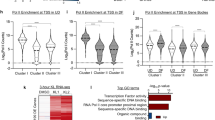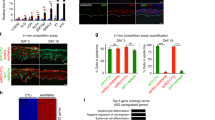Abstract
E2F transcription factors regulate proliferation, differentiation, DNA repair and apoptosis. Tight E2F regulation is crucial for epidermal formation and regeneration. However, virtually nothing is known about the molecular events modulating E2F during epidermal keratinocyte differentiation. Elucidation of these events is essential to understand epidermal morphogenesis, transformation and repair. Here we show that, in differentiating keratinocytes, Ca2+-induced protein kinase C (PKC) activation downregulates E2F1 protein levels. Further, we have identified PKCδ and η as those isoforms specifically involved in induction of E2F1 proteasomal degradation. We also demonstrate that E2F1 downregulation by novel PKC isozymes requires activation of p38β mitogen-activated protein kinase (MAPK). This is the first example of regulation in the E2F transcription factor family by activation of PKC and MAPK in the context of biologically significant differentiation stimuli in epithelia.
This is a preview of subscription content, access via your institution
Access options
Subscribe to this journal
Receive 50 print issues and online access
$259.00 per year
only $5.18 per issue
Buy this article
- Purchase on Springer Link
- Instant access to full article PDF
Prices may be subject to local taxes which are calculated during checkout







Similar content being viewed by others
References
Alt A, Ohba M, Li L, Gartsbein M, Belanger A, Denning MF, Kuroki T, Yuspa SH and Tennenbaum T . (2001). Cancer Res., 61, 4591–4598.
Apostolova MD, Ivanova IA, Dagnino C, D'Souza SJA and Dagnino L . (2002). J. Biol. Chem., 277, 34471–34479.
Bell LA and Ryan KM . (2004). Cell Death Differ., 11, 137–142.
Brennan P, Babbage JW, Burgering BM, Groner B, Reif K and Cantrell DA . (1997). Immunity, 7, 679–689.
Cabodi S, Calautti E, Talora C, Kuroki T, Stein PL and Dotto GP . (2000). Mol. Cell, 6, 1121–1129.
Cam H and Dynlacht BD . (2003). Cancer Cell, 3, 311–316.
Campanero MR and Flemington EK . (1997). Proc. Natl. Acad. Sci. USA, 94, 2221–2226.
Carpenter L, Cordery D and Biden TJ . (2001). J. Biol. Chem., 276, 5368–5374.
Cazzoli R, Craig DL, Biden TJ and Scmitz-Pfeiffer C . (2002). Am. J. Physiol., 282, 1204–1213.
Chang WY, Bryce DM, D'Souza SJA and Dagnino L . (2004). J. Biol. Chem., 279, 51343–51353.
Chida K, Hara T, Hirai T, Konishi C, Nakamura K, Nakao K, Aiba A, Katsuki M and Kuroki T . (2003). Cancer Res., 63, 2404–2408.
D'Souza SJA, Pajak A, Balazsi K and Dagnino L . (2001). J. Biol. Chem., 276, 23531–23538.
D'Souza SJA, Vespa A, Murkherjee S, Maher A, Pajak S and Dagnino L . (2002). J. Biol. Chem., 277, 10626–10632.
Dashti SR, Efimova T and Eckert RL . (2001). J. Biol. Chem., 276, 8059–8063.
Denning MF . (2004). Int. J. Biochem. Cell Biol., 36, 1141–1146.
Dicker AJ, Popa C, Dahler AL, Serewko MM, Hilditch-Maguire PA, Frazer IH and Saunders NA . (2000). Oncogene, 19, 2887–2894.
Dotto GP . (1999). Crit. Rev. Oral Biol. Med., 10, 442–457.
Eckert RL, Crish JF, Efimova T, Dashti SR, Deucher A, Bone F, Adhikaray G, Huag G, Gopalakrishnan R and Balasubramanian S . (2004). J. Invest. Dermatol., 123, 13–22.
Efimova T, Deucher A, Kuroki T, Ohba M and Eckert RL . (2002). J. Biol. Chem., 277, 31753–31760.
Efimova T, La Cell P, Welter JF and Eckert RL . (1998). J. Biol. Chem., 38, 24387–24395.
Engelman JA, Lisanti MP and Scherer PE . (1998). J. Biol. Chem., 273, 32111–32120.
Faigle R, Brederlau A, Elmi M, Arvidsson Y, Hamazaki TS, Uramoto H and Funa K . (2004). Mol. Cell. Biol., 24, 280–293.
Hateboer G, Kerkhoven RM, Shvarts A, Bernards R and Beijersbergen RL . (1996). Genes Dev., 10, 2960–2970.
He TC, Zhou S, da Costa LT, Yu J, Kinzler KW and Vogelstein B . (1998). Proc. Natl. Acad. Sci. USA, 95, 2509–2514.
Hofmann F, Martelli F, Livingston DM and Wang Z . (1996). Genes Dev., 10, 2949–2959.
Jiang Y, Chen C, Li Z, Guo W, Gegner JA, Lins S and Han J . (1996). J. Biol. Chem., 271, 17920–17926.
Kashiwagi M, Ohba M, Watanabe H, Ishino K, Kasahara K, Sanai Y, Taya Y and Kuroki T . (2000). Oncogene, 19, 6334–6341.
Koster MI and Roop DR . (2004). Eur. J. Cell. Biol., 83, 625–629.
Kumar S, Boehm J and Lee JC . (2003). Nat. Rev. Drug Discov., 2, 717–726.
Li L, Lorenzo PS, Bogi K, Blumberg PM and Yuspa SH . (1999). Mol. Cell. Biol., 19, 8547–8558.
Luowei LI, Lorenzo PS, Bogi K, Blumberg PM and Yuspa SA . (1999). Mol. Cell. Biol., 19, 8547–8558.
Martelli F, Hamilton T, Silver DP, Sharpless NE, Bardeesy N, Rokas M, DePinho RA, Livingston DM and Grossman SR . (2001). Proc. Natl. Acad. Sci. USA, 98, 4455–4460.
Ohba M, Ishino K, Kashiwagi M, Kawabe S, Chida K, Huh NH and Kuroki T . (1998). Mol. Cell. Biol., 18, 5199–5207.
Paramio JM, Segrelles C, Casanova ML and Jorcano JL . (2000). J. Biol. Chem., 275, 41219–41226.
Peñuelas S, Alemany C, Noe V and Ciudad CJ . (2003). Eur. J. Biochem., 270, 4809–4822.
Pierce AM, Fisher SM, Conti CJ and Johnson DG . (1998). Oncogene, 16, 1267–1276.
Pierce AM, Schneider-Broussard R, Gimenez-Conti IB, Russell JL, Conti CJ and Johnson DG . (1999). Mol. Cell. Biol., 19, 6408–6414.
Porse BT, Pedersen TA, Xu X, Lindberg B, Wewer UM, Friis-Hansen L and Nerlov C . (2001). Cell, 107, 247–258.
Qi X, Li TG, Hu J, Wang J, Simmons H, Miura S, Mishina Y and Zhao GQ . (2004). Proc. Natl. Acad. Sci. USA, 101, 6027–6032.
Reynold NJ, Baldassare JJ, Henderson PA, Shuler JL, Ballas LM, Burns DJ, Moomaw CR and Fisher GJ . (1994). J. Invest. Dermatol., 103, 364–369.
Romanova LY, Alexandrov IA, Nordan RP, Blagosklonny MV and Mushinski JF . (1998). Biochem., 37, 5558–5565.
Ruiz S, Santos M, Segrelles C, Leis H, Jorcano JL, Berns A, Paramio JM and Vooijs M . (2004). Development, 131, 2737–2748.
Scheijen B, Bronk M, van der Meer T and Bernards R . (2003). Mol. Cell. Biol., 23, 3656–3668.
Suzuma K, Takahara N, Suzuma I, Isshiki K, Ueki K, Leitges M, Aiello LP and King GL . (2002). Proc. Natl. Acad. Sci. USA, 99, 721–726.
Vandel L and Kouzarides T . (1999). EMBO J., 18, 4280–4291.
Acknowledgements
We thank Drs F Beier, S Li and D Litchfield for helpful comments on the manuscript, and H Dupuis for technical assistance. This work was supported by grants to LD from the National Science and Engineering Research Council of Canada, and the National Cancer Institute of Canada (NCIC) with funds from the Canadian Cancer Society and the Terry Fox Foundation, raised through the Terry Fox Run. IAI is a Research student of the Terry Fox Foundation, through an award from NCIC. SJAD is a CIHR New Investigator. During the development of this work, LD was a CIHR/Cancer Research Society Inc. New Investigator.
Author information
Authors and Affiliations
Corresponding author
Rights and permissions
About this article
Cite this article
Ivanova, I., D'Souza, S. & Dagnino, L. E2F1 stability is regulated by a novel-PKC/p38β MAP kinase signaling pathway during keratinocyte differentiation. Oncogene 25, 430–437 (2006). https://doi.org/10.1038/sj.onc.1208999
Received:
Revised:
Accepted:
Published:
Issue Date:
DOI: https://doi.org/10.1038/sj.onc.1208999
Keywords
This article is cited by
-
FER kinase promotes breast cancer metastasis by regulating α6- and β1-integrin-dependent cell adhesion and anoikis resistance
Oncogene (2013)
-
Apoptosis Signal-Regulating Kinase1 is Inducible by Protein Kinase Cδ and Contributes to Phorbol Ester-Mediated G1 Phase Arrest Through Persistent JNK Activation
Cell Biochemistry and Biophysics (2011)
-
Identification of the Rage-dependent gene regulatory network in a mouse model of skin inflammation
BMC Genomics (2010)
-
Phosphorylation by p38 MAP kinase is required for E2F1 degradation and keratinocyte differentiation
Oncogene (2009)
-
Human papillomaviruses, cervical cancer and cell polarity
Oncogene (2008)



